
Action in the Nirgedwo Tal, 1759
26th November 2023, 4 Comments
The Seven Years War, Honours of War, 28mm
Another week, another storm – this time with power cuts. My island was cut off from the town this week – the causeway closed due to a storm – so instead Sean 2 and I played a wee game in the house on Sunday afternoon. In this one David joined in, and so it was the two of us as the French, playing Sean and his Prussians and allies. The battleground was a narrow mountainvalley, with a stream and a road down the middle, played out on a 6×4 foot table. 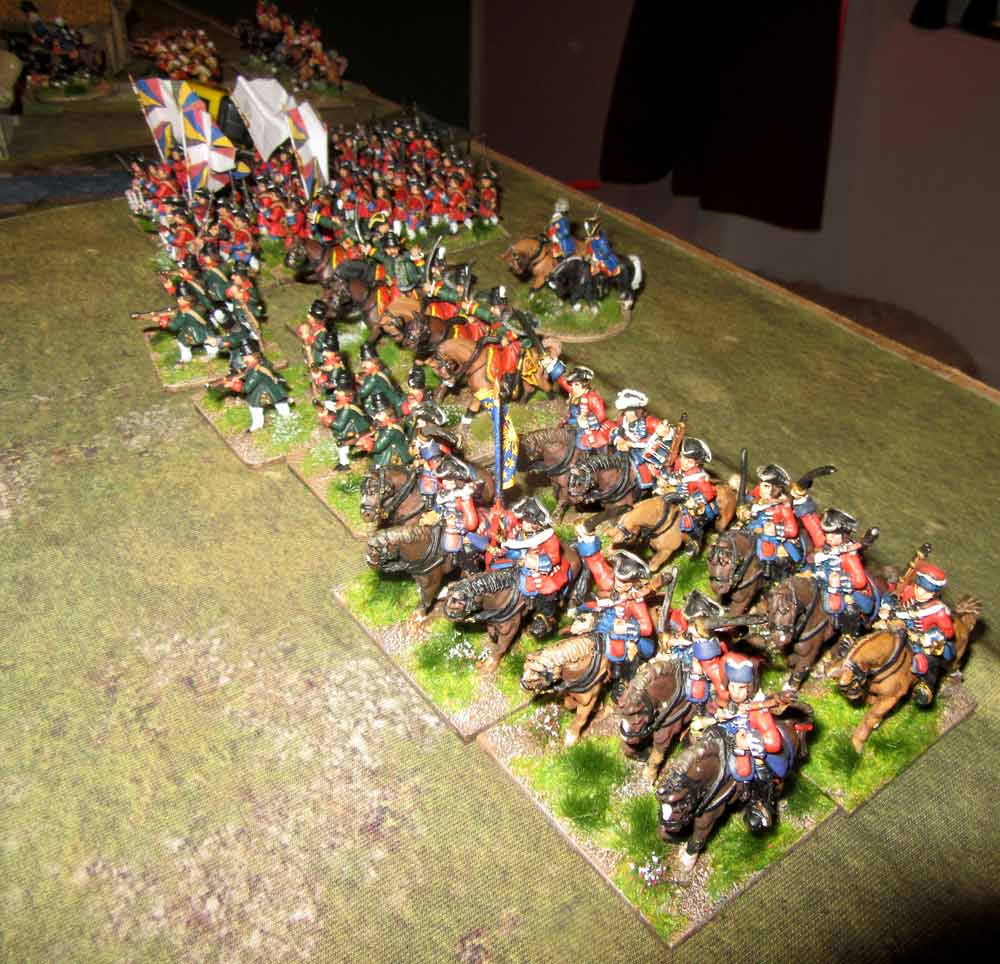 In this one I wanted to try out “legions”, which we portray as paired units – a light infantry battalion, supported by a small cavalry force. The French had two of them – the Chasseurs de Fisher and the Volontaires de Nassau, while the Allies had one – the Freytag Jaegers. the French were backed up by thee cavalry units – two huissar and one dragoon regiment, and two battalions of infantry. The Allies had a similar-sized force, only with Prussian grenadiers.
In this one I wanted to try out “legions”, which we portray as paired units – a light infantry battalion, supported by a small cavalry force. The French had two of them – the Chasseurs de Fisher and the Volontaires de Nassau, while the Allies had one – the Freytag Jaegers. the French were backed up by thee cavalry units – two huissar and one dragoon regiment, and two battalions of infantry. The Allies had a similar-sized force, only with Prussian grenadiers. 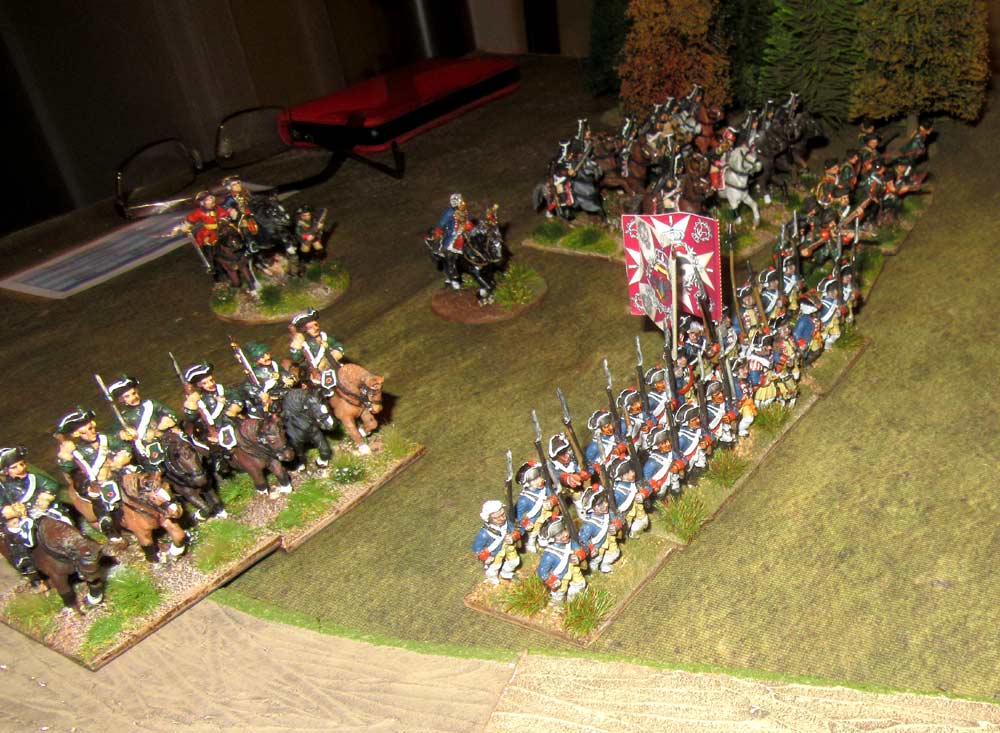 We both appeared at opposite short ends of the table – this was, after all, deciding who would control the valley leading to the mountain pass. We divided our forces into two – one on either side of the stream, with David taking the French left, and I the right. Outnumbered but not outgunned Sean did the same – and for some reason neither of us swapped sides of the stream throughout the game, apart from some of the French light infantry that is.
We both appeared at opposite short ends of the table – this was, after all, deciding who would control the valley leading to the mountain pass. We divided our forces into two – one on either side of the stream, with David taking the French left, and I the right. Outnumbered but not outgunned Sean did the same – and for some reason neither of us swapped sides of the stream throughout the game, apart from some of the French light infantry that is. 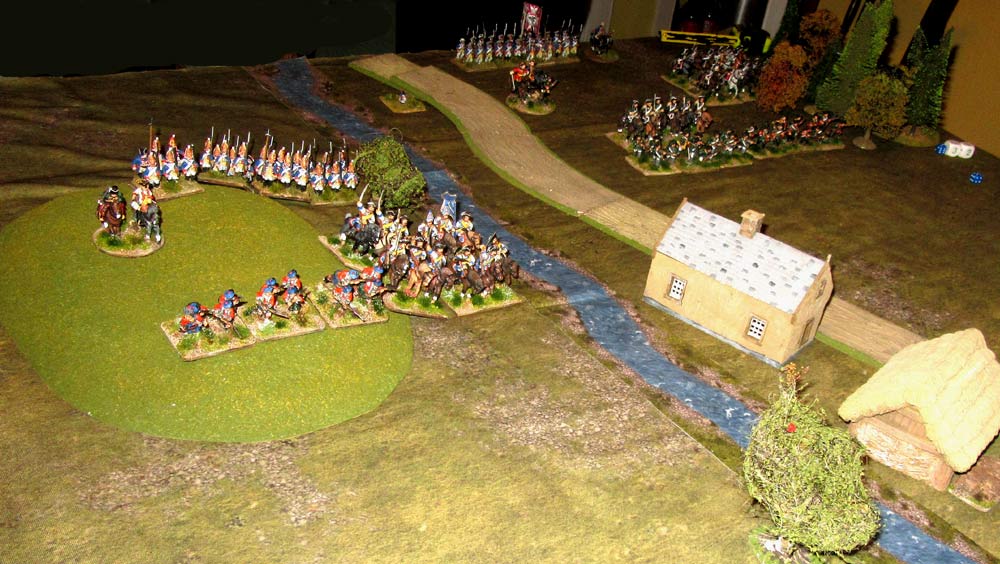 On his right, Sean had some dragoons, a unit of Highlanders (light infantry), and his Prussian grenadiers, matched on my side by my two Swiss line battalions, my dragoons and the Chasseurs de Fisher. On the left was the Prussian musketeer regiment, Prussian hussars, and two light infantry units – one supported by the Freytag mounted component. David faced them with two hussar regiments, and the Voluntaires de Fisher.
On his right, Sean had some dragoons, a unit of Highlanders (light infantry), and his Prussian grenadiers, matched on my side by my two Swiss line battalions, my dragoons and the Chasseurs de Fisher. On the left was the Prussian musketeer regiment, Prussian hussars, and two light infantry units – one supported by the Freytag mounted component. David faced them with two hussar regiments, and the Voluntaires de Fisher. 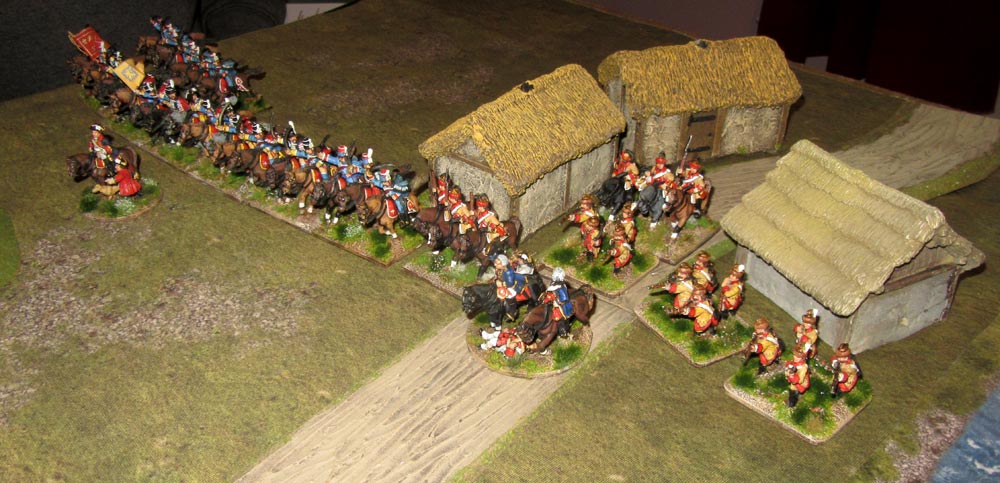 So, although the two sides were roughly equal in points and numbers, neither was quite the same as the other. the Voluntaires began by advancing on Nirgedwo village, where they clashed with the Hanovarian jaegers, who beat them to it. With the support of the Chasseurs de Fisher through, the Hanovarians got driven out of the built-up-area. That effectively helped divide the Prussians and allies in two – and cleared the stage for what followed.
So, although the two sides were roughly equal in points and numbers, neither was quite the same as the other. the Voluntaires began by advancing on Nirgedwo village, where they clashed with the Hanovarian jaegers, who beat them to it. With the support of the Chasseurs de Fisher through, the Hanovarians got driven out of the built-up-area. That effectively helped divide the Prussians and allies in two – and cleared the stage for what followed. 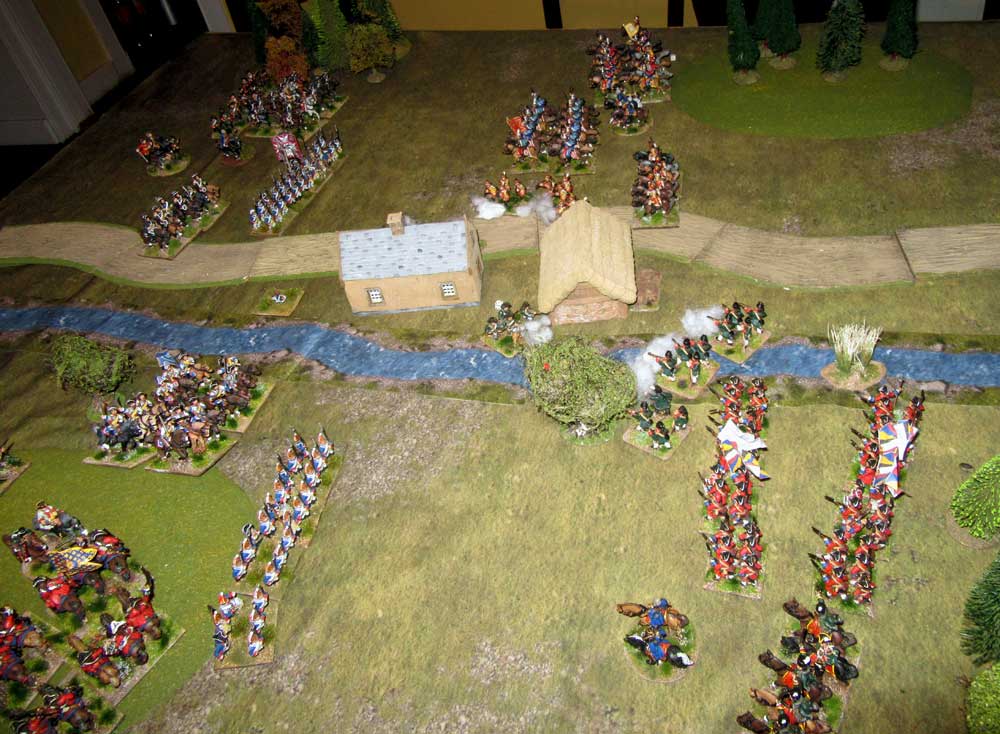 On my side both sides advanced, but Sean decided to occupy a low hill, with his grenadiers deployed in line, and the Highlanders on their right flank. I saw my chance and bypassed the grenadiers with my French Le Roy dragoons, to charge the Highlanders on their right rear. Sensibly the Highlanders fired and then evaded. That though, left my cavalry formed up on the hill, behind the grenadiers. that slightly surprised all of us – and left Sean with a problem.
On my side both sides advanced, but Sean decided to occupy a low hill, with his grenadiers deployed in line, and the Highlanders on their right flank. I saw my chance and bypassed the grenadiers with my French Le Roy dragoons, to charge the Highlanders on their right rear. Sensibly the Highlanders fired and then evaded. That though, left my cavalry formed up on the hill, behind the grenadiers. that slightly surprised all of us – and left Sean with a problem. 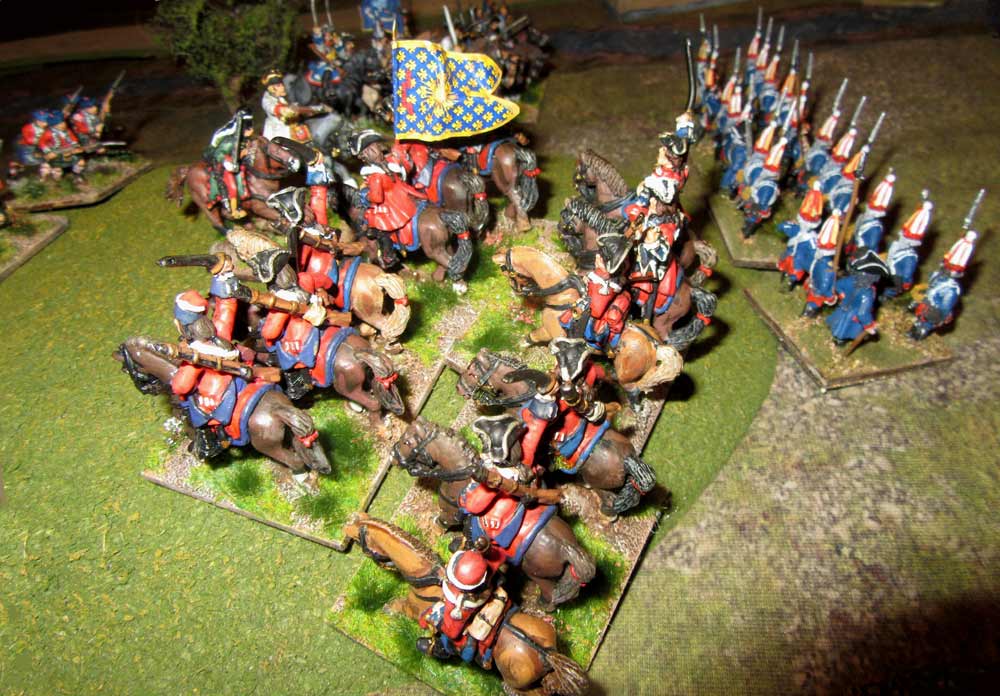 Sean failed to countercharge with his own Hanovarian Briedenbach dragoons, and my own dragoons, getting a double move, turned and slammed into their enemy counterparts. The Hanovarian dragoons broke and fled, leaving my cavalry to launch a second charge into the Highlanders. Once again they evaded, but that left the poor Prussian grenadiers hung out to dry, with enemies to front and rear. My dragoons though, then had to retire to reform.
Sean failed to countercharge with his own Hanovarian Briedenbach dragoons, and my own dragoons, getting a double move, turned and slammed into their enemy counterparts. The Hanovarian dragoons broke and fled, leaving my cavalry to launch a second charge into the Highlanders. Once again they evaded, but that left the poor Prussian grenadiers hung out to dry, with enemies to front and rear. My dragoons though, then had to retire to reform.  Meanwhile on the far side of the river Davis’s Royal Nassau hussars also charged the Hessian jagers, who evaded, and he followed on into the Prussian Von Reusch hussars behind. In this clash though, both sides suffered, but it was the French cavalry who had to retreat. As my dragoons arrived to recover from their hits, David launched the Bercheny hussars, and this time they routed their Prussian counterparts, leaving another hole in the Prussian line.
Meanwhile on the far side of the river Davis’s Royal Nassau hussars also charged the Hessian jagers, who evaded, and he followed on into the Prussian Von Reusch hussars behind. In this clash though, both sides suffered, but it was the French cavalry who had to retreat. As my dragoons arrived to recover from their hits, David launched the Bercheny hussars, and this time they routed their Prussian counterparts, leaving another hole in the Prussian line.  Things were all starting to unravel for the Prussians. They then got a bit worse. As my Swiss La Planta infantry faced off against the Prussian grenadiers, the mounted detachment of the Chasseurs de Fisher rode behind them, to keep the Highlanders at bay, while their light infantry element began swarming around the grenadier’s left flank. So, the unfortunate grenadiers found themselves threatened from the front, rear and flank all at the same time.
Things were all starting to unravel for the Prussians. They then got a bit worse. As my Swiss La Planta infantry faced off against the Prussian grenadiers, the mounted detachment of the Chasseurs de Fisher rode behind them, to keep the Highlanders at bay, while their light infantry element began swarming around the grenadier’s left flank. So, the unfortunate grenadiers found themselves threatened from the front, rear and flank all at the same time.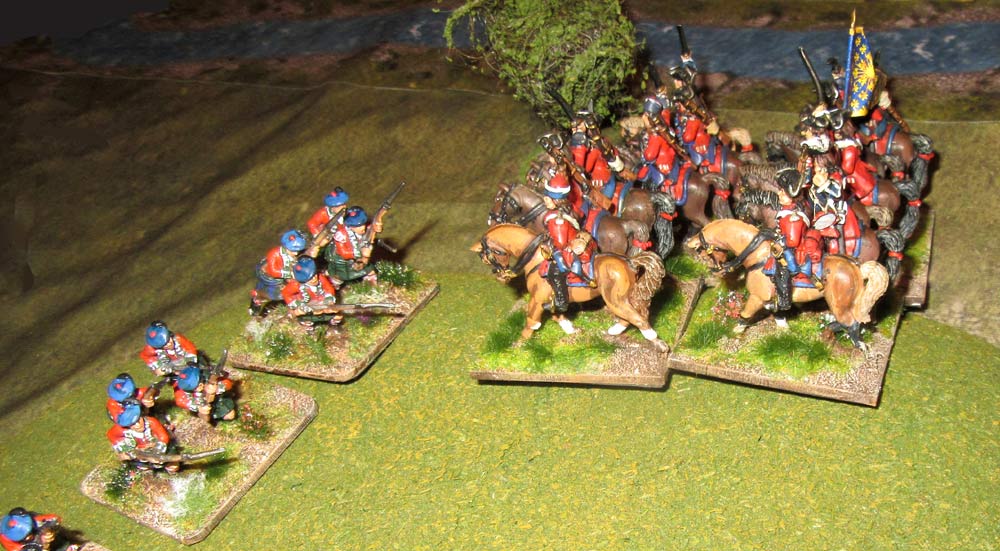 Over on the Prussian left things stabilised a bit, as the French Bercheny hussars managed to ride down the Hessian jaegers, but then had to pull back to lick their wounds. So, almost all of the French cavalry was doing exactly that, with the outcome of the battle still in the balance. The key though, was clearly the Prussian grenadiers – rout them and the French would effectively turn the Prussian flank and so win the game.
Over on the Prussian left things stabilised a bit, as the French Bercheny hussars managed to ride down the Hessian jaegers, but then had to pull back to lick their wounds. So, almost all of the French cavalry was doing exactly that, with the outcome of the battle still in the balance. The key though, was clearly the Prussian grenadiers – rout them and the French would effectively turn the Prussian flank and so win the game. 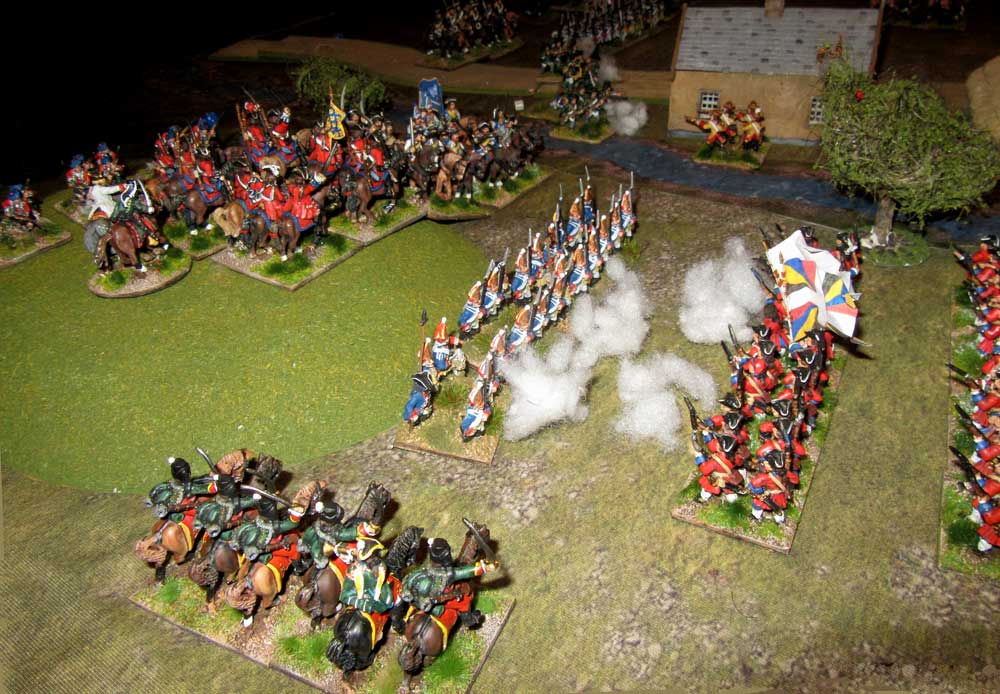 In the end it was all fairly easy. The La Planta fired into the grenadiers, and they fired back, causing more casualties. the Swiss though, had two battalions, with the second in support, so it advanced to the front, and this time it outshot the Prussians. Once they were weakened the Chasseurs de Fisher cavalry unit charged into their rear, and the other French joined in the fray. This was all too much, and the Prussian grenadiers broke and ran.
In the end it was all fairly easy. The La Planta fired into the grenadiers, and they fired back, causing more casualties. the Swiss though, had two battalions, with the second in support, so it advanced to the front, and this time it outshot the Prussians. Once they were weakened the Chasseurs de Fisher cavalry unit charged into their rear, and the other French joined in the fray. This was all too much, and the Prussian grenadiers broke and ran.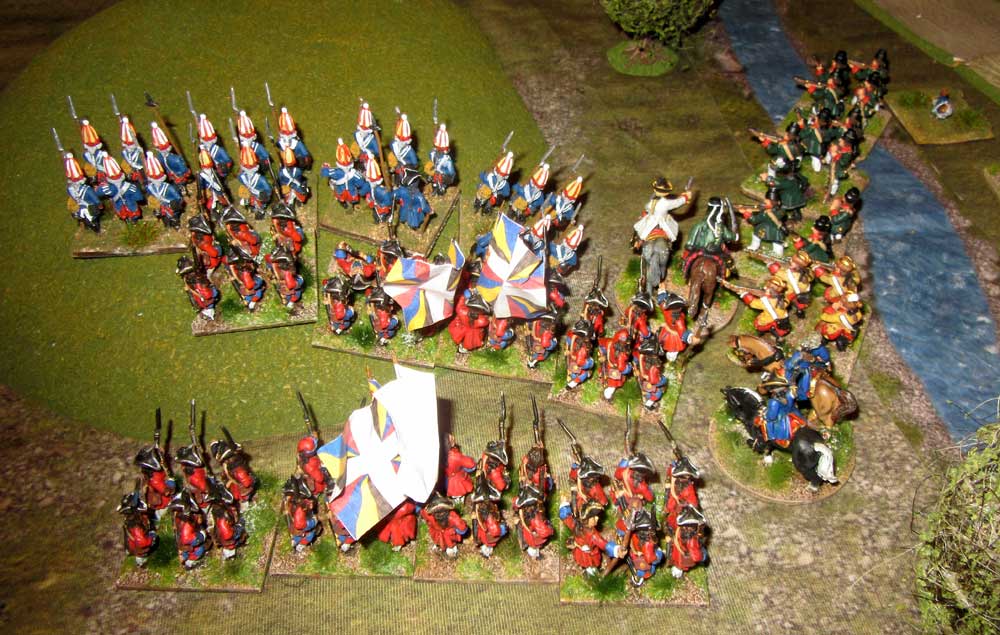 That then, was the end of the game. Having lost too many units the Prussians had reached their army break point, and duly quit the field. It was all quite a fun, leisurely little game, and the experiment with the Legions of light battalions and small cavalry units sort of worked. Above all though, the rule managed to cope with whatever nonsense we threw at them, and the whole game flowed as smoothly as a well-oiled Swiss infantryman’s clock.
That then, was the end of the game. Having lost too many units the Prussians had reached their army break point, and duly quit the field. It was all quite a fun, leisurely little game, and the experiment with the Legions of light battalions and small cavalry units sort of worked. Above all though, the rule managed to cope with whatever nonsense we threw at them, and the whole game flowed as smoothly as a well-oiled Swiss infantryman’s clock. 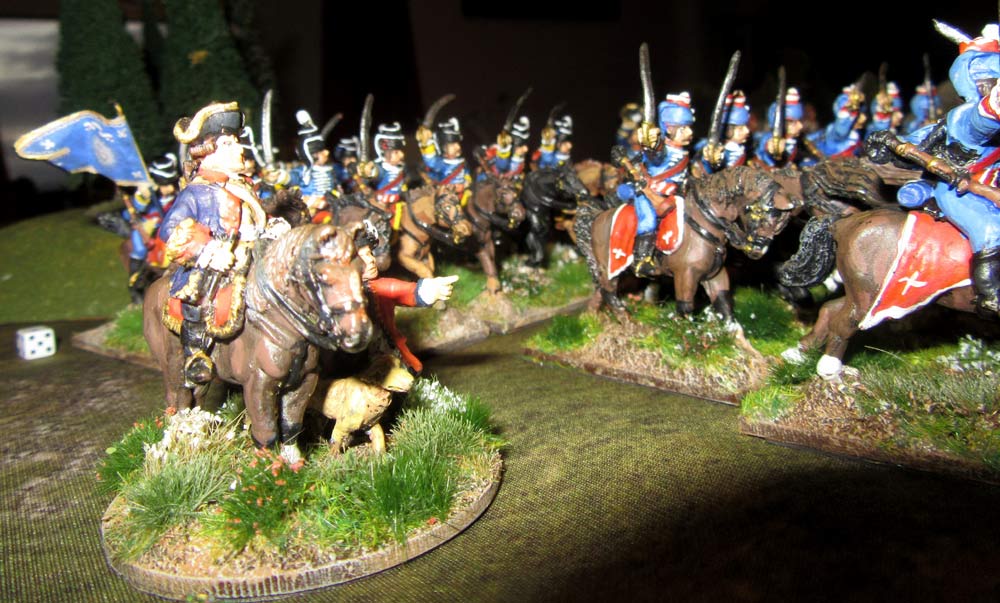


Enjoyable little game as ever. I agree that the rules coped with the legions really well. I don’t think I mastered their use and all that they did was get in the way of my firing line. Interesting idea though and probably better at skirmishing in some kind of forest against other light forces.
I don’t know how to use them either Sean… but the notion was popular, and re-emerged in the AWI. I think there needs to be a way of one unit supporting the other, say when charged by cavalry. WIP…
Thanks for that, Angus. That idea appeared to be a success. I’ve often toyed with the idea of gaming a kind of “kleiner krieg” action so it was interesting to see how your game panned out using the flexibility of these rules to brigade light infantry with cavalry to create the “combined arms” legions of the period. As for using these “combined arms” mini-brigades effectively in a game, I suppose tactics will develop with experience. For example, I vaguely recall that the rules do award a +1 for support in a melee, so one unit could support the other if it is contacted by a charge. I’m also wondering if the light infantry could be used to support the horse like Commanded Shot of the 17th century.
Yes David, I like that support in melee idea, while the ability of the cavalry to support their infantry (usually LI) from charging enemy cavalry might be sensible too. Work in Progress..!